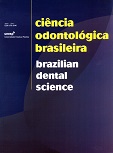An investigation of the optical density of composite resin using digital radiography
DOI:
https://doi.org/10.14295/bds.2004.v7i2.482Abstract
The aim of this study was to verify the radiopacity of four microhibridas composed resin: Filmagic – Vigodent,Herculite – Kerr, TPH – Dentsply, W3D – Wilcos in the color A3 and compares them with the dental enamelusing direct digital radiography system. Acrylic Plates of 20mm for 30mm had been used, in the thickness 1mm,2mm and 3mm, contend four cavities which had been filled with resins composed, it was used three human teethin the same thickness, 36 samples was confected. The specimens were stored at 37 ± 1ºC and immersed indistillate water. The specimens and the human tooth had been radiographed with the Dentsply – Gendex 765DC®from a distance of 40cm and to capture the images, a charge-coupled-device system for digital radiography(Visualix® Dentsply-Gendex) and a software DIGORA® for Windows®. The results submitted to statistical analysis(Tukey´s test a variance analyze ANOVA) showed that there was statistical difference among the opticaldensity of the dental enamel and composite resins, being that the composite resin TPH presented 220,76 (1mm),239,32 (2mm) e 244,09 (3mm), followed by Herculite 192,87 (1mm), 211,67 (2mm) e 225,16 (3mm); W3D 179,90(1mm), 205,07 (2mm) e 220,95 (3mm) e Fill Magic 174,59 (1mm), 190,90 (2mm) e 212,01 (3mm) e enamel113,66 (1mm), 119,97 (2mm) e 143,13 (3mm). The composite resins in the thicknesses studied had presentedoptical density values higher than enamel so they had been satisfied to be used in dental restorations.Downloads
Downloads
Published
How to Cite
Issue
Section
License
Brazilian Dental Science uses the Creative Commons (CC-BY 4.0) license, thus preserving the integrity of articles in an open access environment. The journal allows the author to retain publishing rights without restrictions.
=================




























